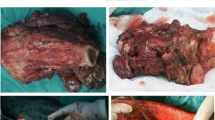Abstract
Introduction
Segmental defects of the tibia after open fractures, sepsis and tumor surgery present a challenging problem. Similarly, tumor surgery often involves radical resections and multiple procedures and is frequently accompanied by irradiation or chemotherapy creating an avascular bed. The aim of this study is to report the results and discuss the role of the ipsilateral pedicle vascularized fibula (IPVF) a technique used for reconstruction of tibia defects.
Materials and methods
Reconstruction of large tibia defects 6–22 cm due to tumor resection were performed in 5 patients by ipsilateral vascularized fibula transposition. The mean age of the patients was 35.4 years (19–42) SD 9.31. The mean follow-up was 59.6 months (24–96) SD 29.2. The mean length of the bone defect was 14.6 cm (6–22) SD 6.066 and the mean time for union was 8 months (6–12) SD 2.82. Arteriography was used preoperatively in all patients to evaluate the lower limb vasculature and to select the optimal surgical approach. The osteosynthesis was stabilized by a plate.
Results
There was sound union in all cases. There were only two minor complications one partial paresis of peroneal nerve and one superficial infection. The mean follow-up was 59.6 months (24–96) SD 29.2. No patient presented with any complaints with the procedure and all had good functional results.
Conclusions
The procedure was technically simple compared to free vascularized fibula and could be performed in hospital with low resources. There are several advantages: (a) achievement of bone defect reconstruction retaining periosteal and endosteal circulation, (b) preservation of a major vessel of the lower leg, (c) avoidance of difficulty and risk of microvascular technique and (d) no donor-morbidity. We routinely recommend preoperative angiography and intraoperatively meticulous dissection to prevent damage to the vascular pedicle.




Similar content being viewed by others
References
Aronson J (1997) Limb-lengthening, skeletal reconstruction, and bone transport with the Ilizarov method. J Bone Joint Surg Am 79:1243–1258
Atkins RM, Madhavan P, Sudhakar J, Whitwell D (1999) Ipsilateral vascularised fibular transport for massive defects of the tibia. J Bone Joint Surg Br 81:1035–1040
Bieber EJ, Wood MB (1986) Bone reconstruction. Clin Plast Surg 13:645–655
Chacha PB, Ahmed M, Daruwalla JS (1981) Vascular pedicle graft of the ipsilateral fibula for non-union of the tibia with a large defect. An experimental and clinical study. J Bone Joint Surg Br 63-B:244–253
Christian EP, Bosse MJ, Robb G (1989) Reconstruction of large diaphyseal defects, without free fibular transfer, in Grade-IIIB tibial fractures. J Bone Joint Surg Am 71:994–1004
Chung YK, Chung S (1998) Ipsilateral island fibula transfer for segmental tibial defects: antegrade and retrograde fashion. Plast Reconstr Surg 101:375–382; discussion 383–374
Cierny G III, Zorn KE (1994) Segmental tibial defects. Comparing conventional and Ilizarov methodologies. Clin Orthop Relat Res 301:118–123
Dick HM, Malinin TI, Mnaymneh WA (1985) Massive allograft implantation following radical resection of high-grade tumors requiring adjuvant chemotherapy treatment. Clin Orthop Relat Res 197:88–95
Gerwin M, Weiland AJ (1992) Vascularized bone grafts to the upper extremity. Indications and technique. Hand Clin 8:509–523
Gordon L, Chiu EJ (1988) Treatment of infected non-unions and segmental defects of the tibia with staged microvascular muscle transplantation and bone-grafting. J Bone Joint Surg Am 70:377–386
Green SA (1994) Skeletal defects. A comparison of bone grafting and bone transport for segmental skeletal defects. Clin Orthop Relat Res 301:111–117
Hertel R, Pisan M, Jakob RP (1995) Use of the ipsilateral vascularised fibula for tibial reconstruction. J Bone Joint Surg Br 77:914–919
Kassab M, Samaha C, Saillant G (2003) Ipsilateral fibular transposition in tibial nonunion using Huntington procedure: a 12-year follow-up study. Injury 34:770–775
Lin CH, Wei FC, Chen HC, Chuang DC (1999) Outcome comparison in traumatic lower-extremity reconstruction by using various composite vascularized bone transplantation. Plast Reconstr Surg 104:984–992
Malizos KN, Nunley JA, Goldner RD, Urbaniak JR, Harrelson JM (1993) Free vascularized fibula in traumatic long bone defects and in limb salvaging following tumor resection: comparative study. Microsurgery 14:368–374
McKee NH, Haw P, Vettese T (1984) Anatomic study of the nutrient foramen in the shaft of the fibula. Clin Orthop Relat Res 184:141–144
Mohler DG, Yaszay B, Hong R, Wera G (2003) Intercalary tibial allografts following tumor resection: the role of fibular centralization. Orthopedics 26:631–637
Ozaki T, Hillmann A, Wuisman P, Winkelmann W (1997) Reconstruction of tibia by ipsilateral vascularized fibula and allograft. 12 cases with malignant bone tumors. Acta Orthop Scand 68:298–301
Shaffer JW, Field GA, Goldberg VM, Davy DT (1985) Fate of vascularized and nonvascularized autografts. Clin Orthop Relat Res 197:32–43
Toh S, Tsubo K, Nishikawa S, Narita S, Kanno H, Harata S (2001) Ipsilateral pedicle vascularized fibula grafts for reconstruction of tibial defects and non-unions. J Reconstr Microsurg 17:487–496
Tu YK, Yen CY, Yeh WL, Wang IC, Wang KC, Ueng WN (2001) Reconstruction of posttraumatic long bone defect with free vascularized bone graft: good outcome in 48 patients with 6 years’ follow-up. Acta Orthop Scand 72:359–364
Vail TP, Urbaniak JR (1996) Donor-site morbidity with use of vascularized autogenous fibular grafts. J Bone Joint Surg Am 78:204–211
Weiland AJ (1981) Current concepts review: vascularized free bone transplants. J Bone Joint Surg Am 63:166–169
Weiland AJ (1984) Vascularized bone transfers. Instr Course Lect 33:446–460
Yazar S, Lin CH, Wei FC (2004) One-stage reconstruction of composite bone and soft-tissue defects in traumatic lower extremities. Plast Reconstr Surg 114:1457–1466
Author information
Authors and Affiliations
Corresponding author
Rights and permissions
About this article
Cite this article
Theos, C., Koulouvaris, P., Kottakis, S. et al. Reconstruction of tibia defects by ipsilateral vascularized fibula transposition. Arch Orthop Trauma Surg 128, 179–184 (2008). https://doi.org/10.1007/s00402-007-0301-3
Received:
Published:
Issue Date:
DOI: https://doi.org/10.1007/s00402-007-0301-3




